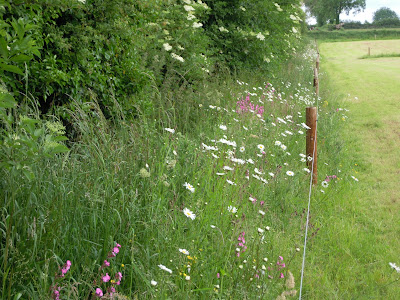The BRIDE project kicks off
A new project in the Bride Valley in east
Cork will reward participating farmers for wildlife on their farms. The ‘Biodiversity
Regeneration In a Dairying Environment’ (BRIDE) project will provide participating
farmers with farm habitat plans that identify the most appropriate and
effective wildlife management options for individual farms. Farmers will be
paid for their conservation actions.
Performance-related payments for farmland wildlife
The BRIDE project was one of eleven projects
selected from over 100 applications by DAFM
and the European Union, under the European Innovation Partnership (EIP) funding
programme. An innovative element of the project is its higher payments for
higher wildlife gains (a results-based approach). Thus, the more flowers in a
hedgerow or field margin, the higher the payment. The greater reward for a higher
quality product is very familiar to farmers, and the BRIDE project applies this
principle to the management of wildlife habitats. This also means that farmers
will be paid for the ongoing management of selected existing wildlife habitats,
which is an important feature of the project.
Field margins that flower and form a dense vegetation provide a habitat for flowering plants, as well as cover and food for farmland wildlife such as birds and bumblebees. Farmers participating in the BRIDE project will be paid for their existing field margins, and can be paid to create new field margins. The more flowers in a hedgerow or field margin, the higher the payment.
|
Farm plans will use an ecologist to identify best options, and agree these with participating farmers
An ecologist will work with participating farmers to develop a farm plan and advise on how to maximise the wildlife on their farm, and will focus on important habitats such as hedgerows, bogs, woodland, ponds, derelict buildings etc. Wild birds and other animals don’t respect farm boundaries, and the BRIDE Project is also designed to work at a landscape scale. It will involve several clusters of neighbouring farms to collectively enhance biodiversity on a much larger scale than would be possible on an individual farm basis.
The Project will run for five years and is
designed to increase and maintain biodiversity on intensively managed farms in
the area through simple, innovative measures. The effects on wildlife will be
monitored through the project, which aims to create suitable habitats for local
important populations of wildlife include skylarks, yellowhammers, bumblebees
and frogs and newts. The BRIDE Project differs from traditional
agri-environment schemes through its use of a results-based payment system i.e.
more farmland habitats will result in higher financial payments.
|
Hedgerows are an important source
of food and habitat for wildlife in the Irish countryside. Their management has
a large impact on wildlife; here, the flowering hedge is a wonderful resource
for bees and butterflies, and the berries will be major food item for birds
later in the season. The taller emerging trees are perfect for breeding birds.
|
Background
information
Contact
details
Donal Sheehan (Project Manager)
Landline 025 36202
Mobile: 087 2292880
Email: enquiries@thebrideproject.ie
Website: www.thebrideproject.ie
The BRIDE Project: Farming with Nature was
designed by two farmers from east Cork, Paul Moore, a tillage farmer from
Midleton and Donal Sheehan, a dairy farmer from Castlelyons, along with Tony
Nagle, an ecologist from Minane Bridge. Additional support was given by John
Finn and Daire Ó hUallacháin (both Teagasc), Alex Copland, (Birdwatch Ireland)
and industry partners Glanbia, Kepak, Cork Co. Council, The National Biodiversity
Data Centre and Bord Bia’s Origin Green Programme.



No comments:
Post a Comment